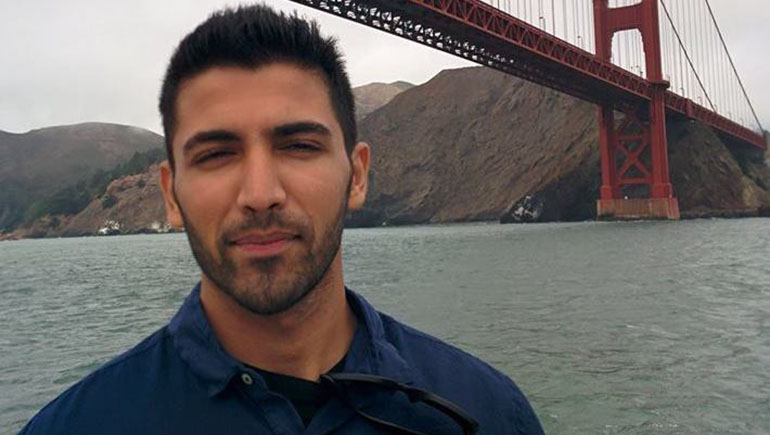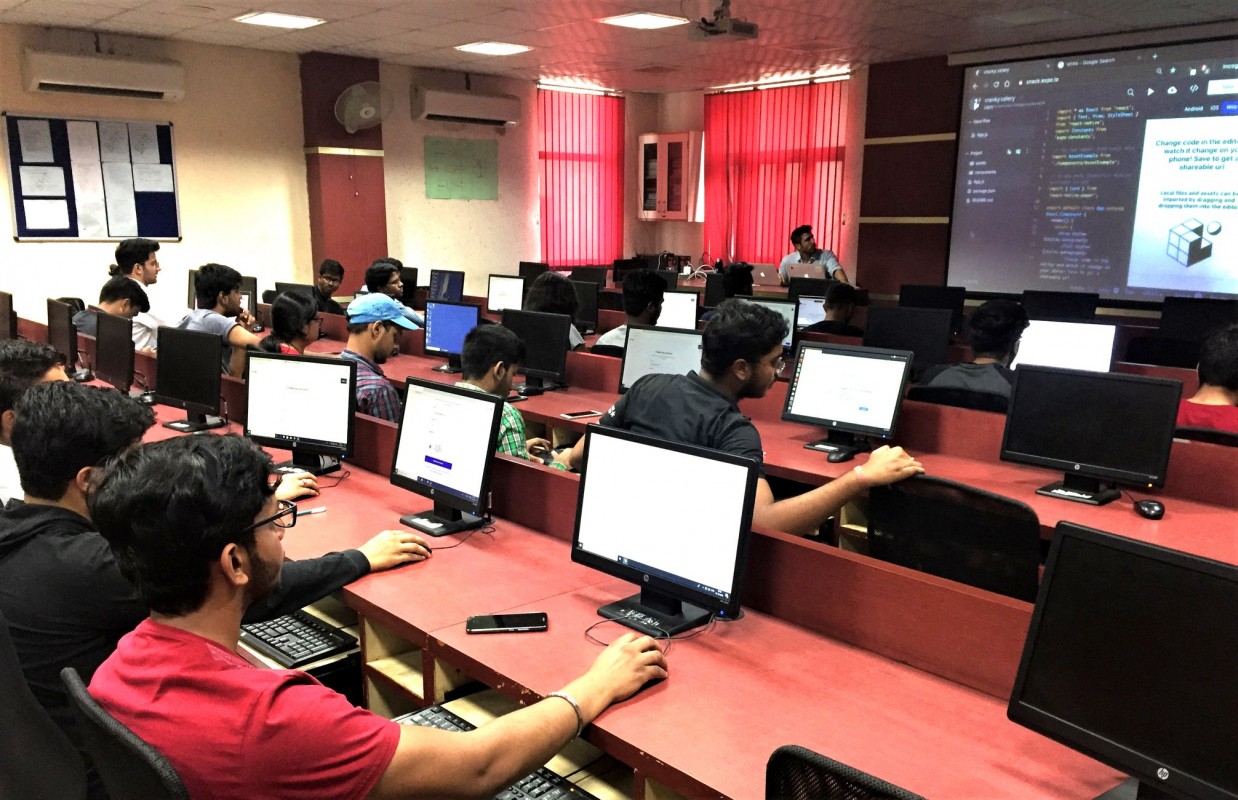Alumni Spotlight: Mudit Goel ’12
Computer science alumnus is the founder of Coding Elements, which is remotely teaching 2 million Indian students

When Mudit Goel ’12 studied computer science at Binghamton University, he and some of his classmates at the Thomas J. Watson College of Engineering and Applied Science founded their own coding club — strictly unofficial, of course.
Their goal was to learn programming beyond what they did in their classes. They also were determined to get good internships and, after graduation, land the best tech jobs. They’d practice interview questions, and when one would get stuck on a knotty problem, the others would jump in to help.
The hard work and persistence paid off: Goel worked in California for five years (at LinkedIn and Intuit) before following his heart, which told him he wasn’t meant to be in the corporate world.
Today, he’s back in his native Delhi, India, as the founder of Coding Elements. The school started in 2017 with just three classrooms but began to expand online even before the COVID-19 pandemic started. (A hundred Binghamton University students took a Coding Elements course in summer 2020.)
Last year, the government of India selected Coding Elements to provide courses to 2 million students in grades 7 and up at 6,000 schools, with the quality of educational content and student reviews as major factors in the decision.
Amid the success, Goel is keeping his eyes on the future: “In addition to coding, there’s a ‘hidden’ curriculum of soft skills like compassion and perseverance. Just having that vocabulary is important, and that’s a direction our company is planning to go.”
QUESTION: How did you decide to come to Binghamton University to pursue computer science?
ANSWER: My decision to go to the U.S. for higher education was not planned in advance. I think that was decided around May or June before I arrived here. I had only one or two months to prepare for my SATs.
One constraint was that my elder brother would also be going to the U.S. for his MBA, so my parents wanted both of us to go to the same college. My brother and I flew in on the same flight, and both of us went to Binghamton. I did my bachelor’s in computer science, and he did his MBA.
Q: Have you always had an interest in the business side of things, too?
A: Yes. Sometimes I feel like I’m not focused, but now it’s turning out that all the interests I’ve had — business, technology, governance and art — are all coming together.
When I was in my junior year, I was spending all of my free time preparing for coding competitions. In the Engineering Building, there is a computer lab in G-7 where I spent a lot of time just practicing. The first interview call I ever received in my life was Facebook, but I did not get that internship.
Around December, I got a call from Google, cleared all the interviews and went through all the technical rounds, and then got the internship offer letter. In February or March, though, I got notice that my internship was canceled. They could not find a suitable team for me. That was very crushing, because I had been focused on getting into a good software company.
Luckily, I had one other offer from Intuit, and they were gracious enough to let me do the internship. Those were the best few months of my entire life so far. They also extended my internship, so I did one semester from San Diego remotely. Professor [Eileen] Head let me take a few online courses and do a research project while I was there so that I could remain a full-time student.
This was the first time in my life that I was getting a paycheck, and having that financial independence and a place in the world meant a lot. This was a big burden off my shoulders, because ever since my brother and I landed in New York, my one and only goal was to make sure that all the money we invested into this [Binghamton education] should have some return.
After graduation, I had a full-time offer from Intuit. I went back to the same team I worked with as an intern and stayed there for around two years. They allowed me to take a few extra courses from Stanford while I was working there.
Because I wanted to move to the Bay Area, I started applying to companies there, and I was lucky enough to get into LinkedIn, which was my first choice. Through all the work that I’ve done, the common thread is that I’ve been able to work in roles helping people to find jobs, become financially independent or get a good education.
Q: Why did you move back to India?
A: I worked at LinkedIn for about one and a half years, and then I wanted to dive deeper into the education space. I took a management job at a midsized company based in Waterloo, Ontario, working on an adaptive-learning data science platform.
After working there for around a year, I wanted to return to India. Despite all of the high salaries, free food and a great life, I was deeply dissatisfied. I don’t know why. I just didn’t see myself doing the same thing for the rest of my life. It was the first time I wasn’t asking myself for a logical explanation — I was just following what I felt like doing. There’s a quote from the Dalai Lama: “For the small decisions in your life, use your brain. For the big decisions, use your heart.”
I did not have a plan. I moved back to New Delhi into my parents’ house. For the first few months back in India, I taught mathematics and basic English in local coaching institutes. Through that time, I started exploring a need in New Delhi for learning about new technology. For example, people in the U.S. were learning Python, but in India they studied C++, which is outdated and less used.
I decided I wanted to start a school with college-level students, focused on teaching Python. Then we introduced machine learning and deep learning — the high-tech, high-growth areas in computer science.
We targeted college-age students with Python courses, and no prior experience was needed. Then they chose machine learning or app development as a follow-up course. The majority of the students who took the two courses had job offers before the courses ended, or within a few months.
We helped them with placements, reaching out to potential employers, such as Amazon, Google and Uber. One placement that stands out is one who was hired by Andrew Ng, who is considered the father of machine learning. He taught at Stanford University and cofounded Coursera. We were very proud that he selected one of our students.
Q: It must have been very exciting when your school was selected to provide coding courses for 2 million students in India.
A: After working with college students in classrooms for two years, we felt that we should start moving the courses online as well. In every cohort of students, around 50% were from outside Delhi and traveling there to take the course. They would ask us where to find a dorm or hostel nearby for three months over the summer or two months over the winter break.
We put the Python course online in late 2019, and it got great reception. A lot of students were taking that course, including students in Kenya, Singapore, Italy and elsewhere. All of this was done through bootstrapping — we haven’t raised any investment, so it’s all happening through my personal savings.
In March 2020, the Indian government announced a nationwide lockdown, because of the COVID crisis, but we already had four courses online at that time. We started promoting those courses and experimenting with teaching coding to younger students via Zoom. We started enrolling schoolkids, and 50% of them were from outside India.
We started to contact potential partners, not really to make money but to reach more students. We made our app development course free, and then I reached out to the government about providing free coding courses to younger students — they could decide which courses, which grade levels and the curriculum. The government was already looking into promoting innovation and coding, so then I started working closely with them. The partnership took a lot of effort on both sides and the journey was so intense.
They’ll use the Coding Elements website as the platform where students will learn and practice how to code using Python. We did training for more than 1,000 teachers, each from a different school. Each teacher will be working with thousands of students.
Q: Apart from academics, were there other lessons you learned at Binghamton that have proven useful in your career?
A: Absolutely. There are many aspects of my four years at Binghamton that allowed me to do all this.
The first one was the flexibility and the willingness of the Computer Science Department to work with students. For instance, when I was in San Diego, all of the other interns had to go back to their colleges, because they would not allow students to work remotely. Professor Head, on the other hand, basically created a customized program for me — she came back with a plan to take courses online. I appreciated that a lot.
The second one was allowing me to do a minor in mathematics, which has proved to be very helpful. A lot of the examples that I use in the videos today come from the math courses that I took.
The third one was interacting with my fellow computer science students. There were many other students like me who came to Binghamton because it was affordable. They could have gone to more elite universities. Once I started meeting students from China, Latin America, the U.S., Canada, Australia and everywhere else, I found there was such an amazing mix of people who came to Binghamton.


